1. Indirect Control through one intermediate entity or person
An individual must be listed as a significant individual if the individual controls:
- an intermediate legal entity or a person that holds 25% or more of the shares or votes of a B.C. private company, or
- an intermediate legal entity or a person that has the right to elect or appoint a majority of the directors of a B.C. private company
An individual generally controls an intermediate entity or a person if they have the legal authority to direct the intermediate entity or person on how to exercise any of the rights that are attached to the shares of the private company.
For example, an individual who owns the majority of the voting shares (typically more than 50%) will enjoy effective control of an intermediate company, including the right to elect a majority of the directors or to replace those directors with others if they are unsatisfied with the way the company is operated.
Because the right to elect, appoint or remove the directors of a company is typically linked to share ownership, all the examples below assume that an individual holding more than 50% of the voting shares of a company will be able to elect or remove a majority of the directors.
Note: it is possible for an individual to be given the right or ability to appoint or remove directors (separate from shares) under the articles of the company or other shareholders’ agreement.
a. What do I do when a shareholder of my company is not a natural person?
Natural persons can only be listed in your company’s register. You will have to get information about who controls that shareholder.
Control of intermediate company
The simplest form of indirect control can be seen in this example below and is commonly referred to as a holding company in which an individual holds shares of a private company through a holding company rather than in their own name. In such case, you must ask who the shareholder of the holding company is and whether the shareholder controls the holding company (owns more than 50% of the voting shares).
Example 1 - Control of intermediate company
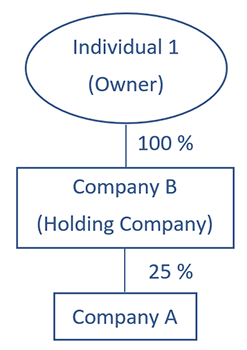
In the diagram above, Individual 1 owns 100% of the shares of Company B which owns 25% of the shares of Company A. As a result, Individual 1 has indirect control of 25% of the shares or votes of Company A and must be listed as a significant individual in Company A’s register.
Example 2 - No control of intermediate company
If no one owns more than 50% of Company B’s shares and no one can otherwise appoint a majority of Company B’s directors, then no one controls Company B. If no one controls Company B, then no one indirectly controls the shares of Company A. Nobody is listed as a significant individual in Company A’s register (the company’s register should still conclude there are no significant individuals – see “Sample Transparency Register Example 3”).
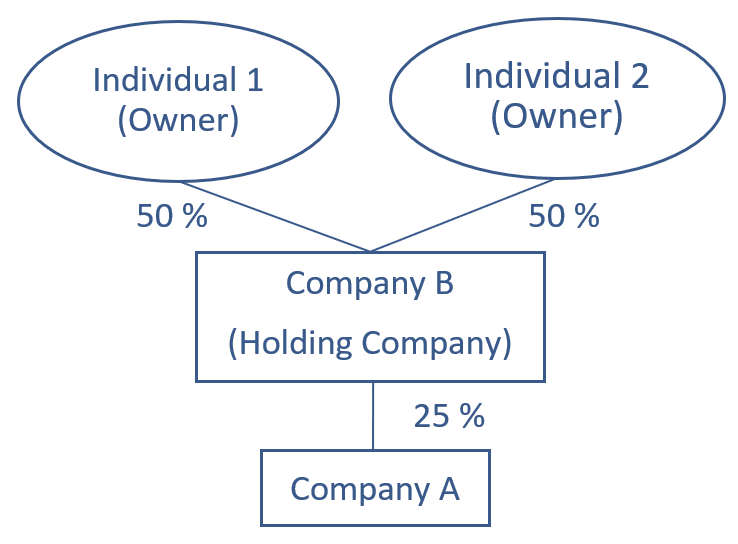
In the diagram above, because neither of the two owners has the ability to elect, appoint or remove a majority of the directors on their own (they do not hold more than 50% of the shares and do not have any special right to appoint directors) and they are not acting in concert, they do not control Company B. As a result, Individual 1 and Individual 2 do not have indirect control of 25% of the shares or votes of Company A. Nobody is listed as a significant individual.
Note: Remember, once the test of control fails, it is no longer possible to have indirect control.
The Section 119.2(3) of the Business Corporations Amendments Act provides that if you conclude there is no significant individual you must state that in your transparency register.
Control of intermediate partnership
Another simple example of indirect control is through a partnership. If the shareholder of your company is a partnership, list all the general partners and non-limited partners as significant individuals in your register.
Limited partners must only be listed if they meet one of the following criteria:
- entitled to at least 25% of the profits of the partnership
- entitled to at least 25% of the assets of the partnership on windup
- has at least 25% of the votes in partnership management
- has the right to appoint or remove the majority of the partnership's management
The partnership agreement should be consulted in order to determine who, if any anyone, meets the above criteria.
Example - Control of intermediate partnership
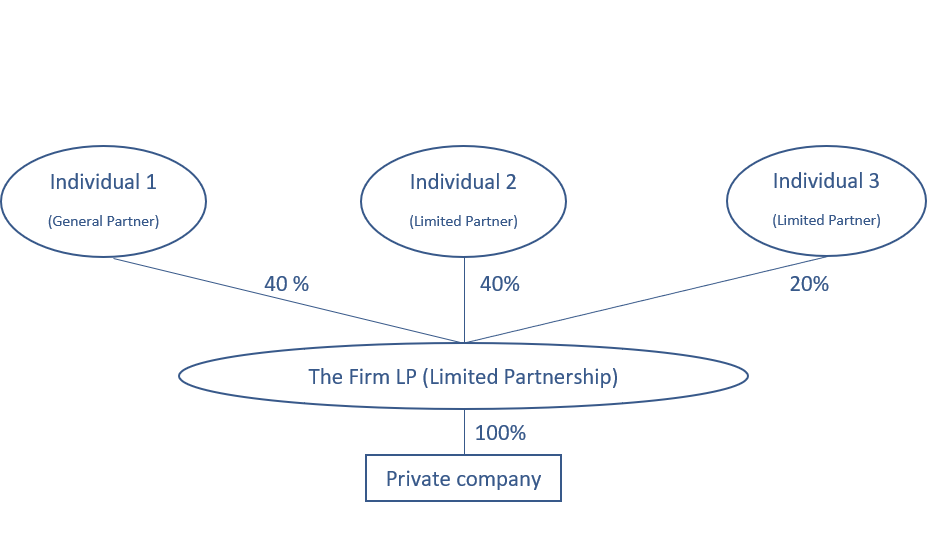 In the diagram above, Individual 1 controls the partnership because Individual 1 is a general partner in the partnership. Individual 2 also controls the partnership because Individual 2 is a limited partner entitled to at least 25% of the profits of the partnership. Individual 3, however, will not control the partnership as Individual 3 is a limited partner entitled to less than 25% of the profits of the partnership. As a result, both Individual 1 and Individual 2 are significant individuals since they have indirect control of the shares of the Private Company.
In the diagram above, Individual 1 controls the partnership because Individual 1 is a general partner in the partnership. Individual 2 also controls the partnership because Individual 2 is a limited partner entitled to at least 25% of the profits of the partnership. Individual 3, however, will not control the partnership as Individual 3 is a limited partner entitled to less than 25% of the profits of the partnership. As a result, both Individual 1 and Individual 2 are significant individuals since they have indirect control of the shares of the Private Company.
b. What do I do when a shareholder of my company is a natural person but is holding the votes or shares on behalf or for the benefit of another person?
If the shareholder holds shares of your company on behalf or for the benefit of another person, you will have to get information about who they hold the shares for and whether that person can tell them how to exercise the rights associated with those shares.
Indirect control through an intermediate agent
An example of indirect control is a registered owner who holds shares on behalf of the true owner. The registered owner is the agent and the true owner is the principal. By operation of law, the agent must follow the directions of the principal. So, it can be said that the principal controls the agent.
Example - Indirect control through an intermediate agent
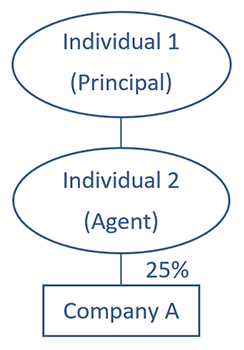
In the diagram above, the agent holds 25% of Company A’s shares on behalf of the principal. Individual 1, the principal, directs or has the right to direct how individual 2, the agent, exercises the rights attached to the shares of Company A. In other words, Individual 1 controls Individual 2. As a result, Individual 1 has indirect control of 25% of the shares or votes of Company A and must be listed as a significant individual in Company A’s register.
Note: As a registered owner of Company A’ shares, the agent must also be listed in the register of the company.
Indirect control through intermediate trustee of a trust
Another example is the trustee of a trust who owns shares of a company for the benefit of the beneficiaries of the trust. In most cases, the trustee will have control over the property of the trust, including the rights associated with shares. You must always list the trustee in your register.
However, the individual who set up the trust, known as the settlor, may have retained the right to control and direct the trustee in matters relating to the trust property, or may have given that right to a beneficiary. If the trustee is taking instructions from the settlor or beneficiary, that individual must also be listed in the register of your company.
Example - Indirect control through intermediate trustee of a trust
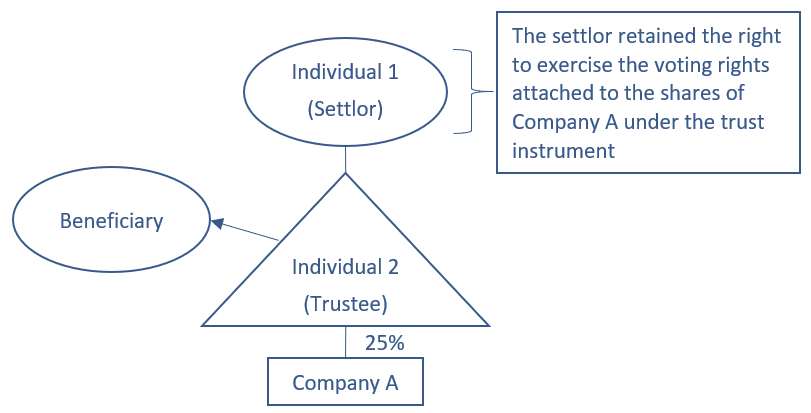 In the diagram above, 25% of the shares of Company A are held in trust for the benefit of the beneficiary. Under the trust instrument, Individual 1, the settlor, controls how the rights attached to Company A’s shares are to be exercised and must be listed as a significant individual in Company A’s register.
In the diagram above, 25% of the shares of Company A are held in trust for the benefit of the beneficiary. Under the trust instrument, Individual 1, the settlor, controls how the rights attached to Company A’s shares are to be exercised and must be listed as a significant individual in Company A’s register.
Note: Where the shares of a company are owned directly by the trustee of a trust for the benefit of a beneficiary, both the trustee, as registered owner, and the beneficiary, as beneficial owner, should also be listed as significant individuals in the company’s register, regardless of whether the instrument creating the trust gives control of trust property to a settlor or beneficiary too.
Indirect control through intermediate personal or legal representative
If a personal or legal representative, such as an attorney under a power of attorney, exercises the rights attached to the shares of your company on behalf of the shareholder or rightsholder, that personal or legal representative must be listed as a significant individual in the company’s register. As when shares of a company are held in trust, you will also need to refer to the representation agreement to determine whether the representative is free to exercise the rights associated with the shares at their discretion. If the represented person:
- kept the legal authority to direct the representative as to how to exercise the rights attached to the shares, or
- has the ability to regain control of the voting rights, the represented person needs to be listed in the company’s register too
Note: The terms of a representation agreement are generally such that a represented shareholder or rightsholder will keep actual control – or at least the ability to regain control – of how the rights attached to the shares of a company are to be exercised. As a result, it is almost always the case that the represented person will have to be listed as a significant individual in the company’s register, along with the personal or legal representative.
